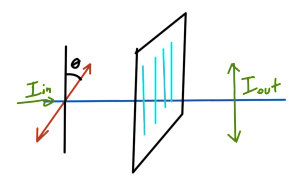[Click here for a PDF of this post with nicer formatting]
Mixed ensemble averages
In [1], Sakurai leaves it to the reader to verify that knowledge of the three ensemble averages [S_x], [S_y],[S_z] is sufficient to reconstruct the density operator for a spin one half system.
I’ll do this in two parts, the first using a spin-up/down ensemble to see what form this has, then the general case. The general case is a bit messy algebraically. After first attempting it the hard way, I did the grunt work portion of that calculation in Mathematica, but then realized it’s not so bad to do it manually.
Consider first an ensemble with density operator
\begin{equation}\label{eqn:ensemblesForSpinOneHalf:20}
\rho =
w_{+} \ket{+}\bra{+} + w_{-} \ket{-}\bra{-},
\end{equation}
where these are the \( \BS \cdot (\pm \zcap) \) eigenstates. The traces are
\begin{equation}\label{eqn:ensemblesForSpinOneHalf:40}
\begin{aligned}
\textrm{Tr}( \rho \sigma_x )
&=
\bra{+} \rho \sigma_x \ket{+}
+
\bra{-} \rho \sigma_x \ket{-} \\
&=
\bra{+} \rho \begin{bmatrix} 0 & 1 \\ 1 & 0 \\ \end{bmatrix} \ket{+}
+
\bra{-} \rho \begin{bmatrix} 0 & 1 \\ 1 & 0 \\ \end{bmatrix} \ket{-} \\
&=
\bra{+} \lr{ w_{+} \ket{+}\bra{+} + w_{-} \ket{-}\bra{-} } \ket{-}
+
\bra{-} \lr{ w_{+} \ket{+}\bra{+} + w_{-} \ket{-}\bra{-} } \ket{+} \\
&=
\bra{+} w_{-} \ket{-}
+
\bra{-} w_{+} \ket{+} \\
&=
0,
\end{aligned}
\end{equation}
\begin{equation}\label{eqn:ensemblesForSpinOneHalf:60}
\begin{aligned}
\textrm{Tr}( \rho \sigma_y )
&=
\bra{+} \rho \sigma_y \ket{+}
+
\bra{-} \rho \sigma_y \ket{-} \\
&=
\bra{+} \rho \begin{bmatrix} 0 & -i \\ i & 0 \\ \end{bmatrix} \ket{+}
+
\bra{-} \rho \begin{bmatrix} 0 & -i \\ i & 0 \\ \end{bmatrix} \ket{-} \\
&=
i \bra{+} \lr{ w_{+} \ket{+}\bra{+} + w_{-} \ket{-}\bra{-} } \ket{-}
–
i \bra{-} \lr{ w_{+} \ket{+}\bra{+} + w_{-} \ket{-}\bra{-} } \ket{+} \\
&=
i \bra{+} w_{-} \ket{-}
–
i \bra{-} w_{+} \ket{+} \\
&=
0,
\end{aligned}
\end{equation}
and
\begin{equation}\label{eqn:ensemblesForSpinOneHalf:100}
\begin{aligned}
\textrm{Tr}( \rho \sigma_z )
&=
\bra{+} \rho \sigma_z \ket{+}
+
\bra{-} \rho \sigma_z \ket{-} \\
&=
\bra{+} \rho \ket{+}
–
\bra{-} \rho \ket{-} \\
&=
\bra{+} \lr{ w_{+} \ket{+}\bra{+} + w_{-} \ket{-}\bra{-} } \ket{+}
–
\bra{-} \lr{ w_{+} \ket{+}\bra{+} + w_{-} \ket{-}\bra{-} } \ket{-} \\
&=
\bra{+} w_{+} \ket{+}
–
\bra{-} w_{-} \ket{-} \\
&=
w_{+} – w_{-}.
\end{aligned}
\end{equation}
Since \( w_{+} + w_{-} = 1 \), this gives
\begin{equation}\label{eqn:ensemblesForSpinOneHalf:80}
\boxed{
\begin{aligned}
w_{+} &= \frac{1 + \textrm{Tr}( \rho \sigma_z )}{2} \\
w_{-} &= \frac{1 – \textrm{Tr}( \rho \sigma_z )}{2}
\end{aligned}
}
\end{equation}
Attempting to do a similar set of trace expansions this way for a more general spin basis turns out to be a really bad idea and horribly messy. So much so that I resorted to \href{https://raw.githubusercontent.com/peeterjoot/mathematica/master/phy1520/spinOneHalfSymbolicManipulation.nb}{Mathematica to do this symbolic work}. However, it’s not so bad if the trace is done completely in matrix form.
Using the basis
\begin{equation}\label{eqn:ensemblesForSpinOneHalf:120}
\begin{aligned}
\ket{\BS \cdot \ncap ; + } &=
\begin{bmatrix}
\cos(\theta/2) \\
\sin(\theta/2) e^{i \phi}
\end{bmatrix} \\
\ket{\BS \cdot \ncap ; – } &=
\begin{bmatrix}
\sin(\theta/2) e^{-i \phi} \\
-\cos(\theta/2) \\
\end{bmatrix},
\end{aligned}
\end{equation}
the projector matrices are
\begin{equation}\label{eqn:ensemblesForSpinOneHalf:140}
\begin{aligned}
\ket{\BS \cdot \ncap ; + } \bra{\BS \cdot \ncap ; + }
&=
\begin{bmatrix}
\cos(\theta/2) \\
\sin(\theta/2) e^{i \phi}
\end{bmatrix}
\begin{bmatrix}
\cos(\theta/2) &
\sin(\theta/2) e^{-i \phi}
\end{bmatrix} \\
&=
\begin{bmatrix}
\cos^2(\theta/2) & \cos(\theta/2) \sin(\theta/2) e^{-i \phi} \\
\sin(\theta/2) \cos(\theta/2) e^{i \phi} & \sin^2(\theta/2)
\end{bmatrix},
\end{aligned}
\end{equation}
\begin{equation}\label{eqn:ensemblesForSpinOneHalf:160}
\begin{aligned}
\ket{\BS \cdot \ncap ; – } \bra{\BS \cdot \ncap ; – }
&=
\begin{bmatrix}
\sin(\theta/2) e^{-i \phi} \\
-\cos(\theta/2) \\
\end{bmatrix}
\begin{bmatrix}
\sin(\theta/2) e^{i \phi} & -\cos(\theta/2) \\
\end{bmatrix} \\
&=
\begin{bmatrix}
\sin^2(\theta/2) & -\cos(\theta/2) \sin(\theta/2) e^{-i \phi} \\
-\cos(\theta/2) \sin(\theta/2) e^{i \phi} & \cos^2(\theta/2)
\end{bmatrix}
\end{aligned}
\end{equation}
With \( C = \cos(\theta/2), S = \sin(\theta/2) \), a general density operator in this basis has the form
\begin{equation}\label{eqn:ensemblesForSpinOneHalf:180}
\begin{aligned}
\rho
&=
w_{+}
\begin{bmatrix}
C^2 & C S e^{-i \phi} \\
S C e^{i \phi} & S^2
\end{bmatrix}
+
w_{-}
\begin{bmatrix}
S^2 & -C S e^{-i \phi} \\
-C S e^{i \phi} & C^2
\end{bmatrix} \\
&=
\begin{bmatrix}
w_{+} C^2 + w_{-} S^2 & (w_{+} – w_{-})C S e^{-i \phi} \\
(w_{+} -w_{-} ) S C e^{i \phi} & w_{+} S^2 + w_{-} C^2
\end{bmatrix}.
\end{aligned}
\end{equation}
The products with the Pauli matrices are
\begin{equation}\label{eqn:ensemblesForSpinOneHalf:200}
\begin{aligned}
\rho \sigma_x
&=
\begin{bmatrix}
w_{+} C^2 + w_{-} S^2 & (w_{+} – w_{-})C S e^{-i \phi} \\
(w_{+} -w_{-} ) S C e^{i \phi} & w_{+} S^2 + w_{-} C^2
\end{bmatrix}
\begin{bmatrix} 0 & 1 \\ 1 & 0 \\ \end{bmatrix} \\
&=
\begin{bmatrix}
(w_{+} – w_{-})C S e^{-i \phi} & w_{+} C^2 + w_{-} S^2 \\
w_{+} S^2 + w_{-} C^2 & (w_{+} -w_{-} ) S C e^{i \phi} \\
\end{bmatrix}
\end{aligned}
\end{equation}
\begin{equation}\label{eqn:ensemblesForSpinOneHalf:220}
\begin{aligned}
\rho \sigma_y
&=
\begin{bmatrix}
w_{+} C^2 + w_{-} S^2 & (w_{+} – w_{-})C S e^{-i \phi} \\
(w_{+} -w_{-} ) S C e^{i \phi} & w_{+} S^2 + w_{-} C^2
\end{bmatrix}
\begin{bmatrix} 0 & -i \\ i & 0 \\ \end{bmatrix} \\
&=
i
\begin{bmatrix}
(w_{+} – w_{-})C S e^{-i \phi} & -w_{+} C^2 – w_{-} S^2 \\
w_{+} S^2 + w_{-} C^2 & -(w_{+} -w_{-} ) S C e^{i \phi} \\
\end{bmatrix}
\end{aligned}
\end{equation}
\begin{equation}\label{eqn:ensemblesForSpinOneHalf:240}
\begin{aligned}
\rho \sigma_z
&=
\begin{bmatrix}
w_{+} C^2 + w_{-} S^2 & (w_{+} – w_{-})C S e^{-i \phi} \\
(w_{+} -w_{-} ) S C e^{i \phi} & w_{+} S^2 + w_{-} C^2
\end{bmatrix}
\begin{bmatrix} 1 & 0 \\ 0 & -1 \\ \end{bmatrix} \\
&=
\begin{bmatrix}
w_{+} C^2 + w_{-} S^2 & -(w_{+} – w_{-})C S e^{-i \phi} \\
(w_{+} -w_{-} ) S C e^{i \phi} & – (w_{+} S^2 + w_{-} C^2)
\end{bmatrix}
\end{aligned}
\end{equation}
The respective traces can be read right off the matrices
\begin{equation}\label{eqn:ensemblesForSpinOneHalf:260}
\begin{aligned}
\textrm{Tr}( \rho \sigma_x ) &= (w_{+} – w_{-}) \sin\theta \cos\phi \\
\textrm{Tr}( \rho \sigma_y ) &= (w_{+} – w_{-}) \sin\theta \sin\phi \\
\textrm{Tr}( \rho \sigma_z ) &= (w_{+} – w_{-}) \cos\theta \\
\end{aligned}.
\end{equation}
This gives
\begin{equation}\label{eqn:ensemblesForSpinOneHalf:280}
(w_{+} – w_{-}) \ncap = \lr{ \textrm{Tr}( \rho \sigma_x ), \textrm{Tr}( \rho \sigma_y ), \textrm{Tr}( \rho \sigma_z ) },
\end{equation}
or
\begin{equation}\label{eqn:ensemblesForSpinOneHalf:281}
\boxed{
w_{\pm} = \frac{1 \pm \sqrt{ \textrm{Tr}^2( \rho \sigma_x ) + \textrm{Tr}^2( \rho \sigma_y ) + \textrm{Tr}^2( \rho \sigma_z )} }{2} .
}
\end{equation}
So, as claimed, it’s possible to completely describe the ensemble weight factors using the ensemble averages of \( [S_x], [S_y], [S_z] \). I used the Pauli matrices instead, but the difference is just an \( \Hbar/2 \) scaling adjustment.
Pure ensemble
It turns out that doing the above is also pr. 3.10(b). Part (a) of that problem is to show how the expectation values \( \expectation{S_x}, \expectation{S_y},\expectation{S_x} \) fully determine the spin orientation for a pure ensemble.
Suppose that the system is in the state \( \ket{\BS \cdot \ncap ; + } \) as defined above, then the expectation values of \( \sigma_x, \sigma_y, \sigma_z \) with respect to this state are
\begin{equation}\label{eqn:ensemblesForSpinOneHalf:300}
\begin{aligned}
\expectation{\sigma_x}
&=
\begin{bmatrix}
\cos(\theta/2) &
\sin(\theta/2) e^{-i \phi}
\end{bmatrix}
\begin{bmatrix} 0 & 1 \\ 1 & 0 \\ \end{bmatrix}
\begin{bmatrix}
\cos(\theta/2) \\
\sin(\theta/2) e^{i \phi}
\end{bmatrix} \\
&=
\begin{bmatrix}
\cos(\theta/2) &
\sin(\theta/2) e^{-i \phi}
\end{bmatrix}
\begin{bmatrix}
\sin(\theta/2) e^{i \phi} \\
\cos(\theta/2) \\
\end{bmatrix} \\
&=
\sin\theta \cos\phi,
\end{aligned}
\end{equation}
\begin{equation}\label{eqn:ensemblesForSpinOneHalf:340}
\begin{aligned}
\expectation{\sigma_y}
&=
\begin{bmatrix}
\cos(\theta/2) &
\sin(\theta/2) e^{-i \phi}
\end{bmatrix}
\begin{bmatrix} 0 & -i \\ i & 0 \\ \end{bmatrix}
\begin{bmatrix}
\cos(\theta/2) \\
\sin(\theta/2) e^{i \phi}
\end{bmatrix} \\
&=
i
\begin{bmatrix}
\cos(\theta/2) &
\sin(\theta/2) e^{-i \phi}
\end{bmatrix}
\begin{bmatrix}
-\sin(\theta/2) e^{i \phi} \\
\cos(\theta/2) \\
\end{bmatrix} \\
&=
\sin\theta \sin\phi,
\end{aligned}
\end{equation}
\begin{equation}\label{eqn:ensemblesForSpinOneHalf:360}
\begin{aligned}
\expectation{\sigma_z}
&=
\begin{bmatrix}
\cos(\theta/2) &
\sin(\theta/2) e^{-i \phi}
\end{bmatrix}
\begin{bmatrix} 1 & 0 \\ 0 & -1 \\ \end{bmatrix}
\begin{bmatrix}
\cos(\theta/2) \\
\sin(\theta/2) e^{i \phi}
\end{bmatrix} \\
&=
\begin{bmatrix}
\cos(\theta/2) &
\sin(\theta/2) e^{-i \phi}
\end{bmatrix}
\begin{bmatrix}
\cos(\theta/2) \\
-\sin(\theta/2) e^{i \phi}
\end{bmatrix} \\
&=
\cos\theta.
\end{aligned}
\end{equation}
So we have
\begin{equation}\label{eqn:ensemblesForSpinOneHalf:380}
\boxed{
\ncap = \lr{ \expectation{\sigma_x}, \expectation{\sigma_y}, \expectation{\sigma_z} }.
}
\end{equation}
The spin direction is completely determined by this vector of expectation values (or equivalently, the expectation values of \( S_x, S_y, S_z \)).
References
[1] Jun John Sakurai and Jim J Napolitano. Modern quantum mechanics. Pearson Higher Ed, 2014.





